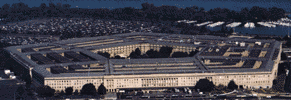Archive


Department of
Defense
1994
Mission Statement
The Department of Defense is responsible for providing the military forces needed to deter war and protect the security of our country.
The major elements of these forces are the Army, Navy, Marine Corps, and Air Force, consisting of about 1.7 million men and women on active duty. Of these, some 518,000 -- including about 67,000 on ships at sea -- are serving outside the United States. They are backed, in case of emergency, by the 1,000,000 members of the reserve components. In addition, there are about 1.1 million civilian employees in the Defense Department.
Under the President, who is also Commander in Chief, the Secretary of Defense exercises authority, direction, and control over the Department, which includes the separately organized military departments of Army, Navy, and Air Force, the Joint Chiefs of Staff providing military advice, the unified and specified combatant commands, and various defense agencies established for specific purposes.
Every State in the Union has some defense activities. Central headquarters of the Department is at the Pentagon, the ``world's largest office building.''
The Department of Defense (DOD) is the successor agency to the National Military Establishment created by the National Security Act of 1947 (50 U.S.C. 401). It was established as an executive department of the Government by the National Security Act Amendments of 1949 with the Secretary of Defense as its head (5 U.S.C. 101). Since that time, many legislative and administrative changes have occurred, evolving the Department into the structure under which it currently operates.
Structure
The Department of Defense is composed of the Office of the Secretary of Defense; the military departments and the military services within those departments; the Chairman of the Joint Chiefs of Staff and the Joint Staff; the unified and specified combatant commands; the Defense agencies; DOD field activities; and such other offices, agencies, activities, and commands as may be established or designated by law, or by the President or the Secretary of Defense.
In providing immediate staff assistance and advice to the Secretary of Defense, the Office of the Secretary of Defense and the Chairman of the Joint Chiefs of Staff, and the Joint Staff, though separately identified and organized, function in full coordination and cooperation.
The Office of the Secretary of Defense includes the offices of the Deputy Secretary of Defense; the Under Secretary of Defense for Acquisition; the Under Secretary of Defense for Policy; the Comptroller of the Department of Defense; Assistant Secretaries of Defense; the General Counsel; the Director of Defense Research and Engineering; the Director of Operational Test and Evaluation; the Inspector General; and such other staff offices as the Secretary of Defense establishes to assist him in carrying out his duties and responsibilities. The heads of these offices are staff advisers to the Secretary and perform such functions as he assigns to them.
The Joint Chiefs of Staff consist of the Chairman; the Vice Chairman; the Chief of Staff, U.S. Army; the Chief of Naval Operations; the Chief of Staff, U.S. Air Force; and the Commandant of the Marine Corps. Supported, subject to the authority of the Chairman, by the Joint Staff, they constitute the immediate military staff of the Secretary of Defense. The Chairman is the principal military adviser to the President, the National Security Council, and the Secretary of Defense. The other members of the Joint Chiefs of Staff are the senior military officers of their respective services and are military advisers to the President, the National Security Council, and the Secretary of Defense. The Vice Chairman of the Joint Chiefs acts as Chairman in the absence of the Chairman.
Each military department (the Department of the Navy includes naval aviation and the United States Marine Corps) is separately organized under its own Secretary and functions under the authority, direction, and control of the Secretary of Defense. The Secretary of each military department is responsible to the Secretary of Defense for the operation and efficiency of his department. Orders to the military departments are issued through the Secretaries of these departments, or their designees, by the Secretary of Defense or under authority specifically delegated in writing by the Secretary of Defense or provided by law.
The commanders of unified and specified combatant commands are responsible to the President and the Secretary of Defense for accomplishing the military missions assigned to them and exercising command authority over forces assigned to them. The operational chain of command runs from the President to the Secretary of Defense to the commanders of the unified and specified combatant commands. The Chairman of the Joint Chiefs of Staf functions within the chain of command by transmitting the orders of the President or the Secretary of Defense to the commanders of the unified and specified combatant commands.